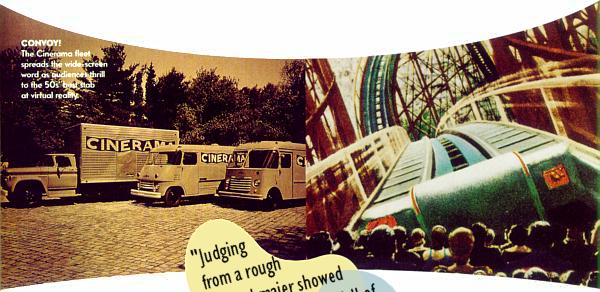|
 his was virtual reality 1950s-style. Audience members, their fields of vision nearly filled by the image, felt as if they too were rushing down the track. People would scream, rock back and forth in their seats, and, if we are to believe press accounts of the day (no doubt informed by ballyhoo), leave the theater at intermission to buy Dramamine. Even though it would play at a total of only 14 expensively converted theaters during its initial two-year run in the U.S., This Is Cinerama, by The Hollywood Reporter's accounting, was the highest grossing film released in 1952. It bettered the likes of High Noon, Singin' in the Rain, and The Quiet Man. his was virtual reality 1950s-style. Audience members, their fields of vision nearly filled by the image, felt as if they too were rushing down the track. People would scream, rock back and forth in their seats, and, if we are to believe press accounts of the day (no doubt informed by ballyhoo), leave the theater at intermission to buy Dramamine. Even though it would play at a total of only 14 expensively converted theaters during its initial two-year run in the U.S., This Is Cinerama, by The Hollywood Reporter's accounting, was the highest grossing film released in 1952. It bettered the likes of High Noon, Singin' in the Rain, and The Quiet Man.
 Nevertheless, in an era when audiences were abandoning movie theaters for the novelty of television, Hollywood was desperate for gimmicks. This is Cinerama would change movies forever-"the greatest invention since talking pictures," as the ads not all that preposterously claimed. It wasn't just that widescreen became an industry standard, or that This Is Cinerama launched an era of oversize, overstuffed superspectaculars that would give us Ben-Hur; Spartacus, and Lawrence of Arabia. Cinerama restored a visceralness to moviegoing that had been largely missing since the nickelodeon, where novice film audiences would flinch at the sight of waves or a man pointing a gun at the camera. As the film historian John Belton argues in his definitive Widescreen Cinema, there is also a direct link between Cinerama and the "roller-coaster ride" movies of George Lucas, Steven Spielberg, and their many disciples, between the opening shot of This Is Cinerama and Luke Skywalker's dizzying joyride through the canyons of the Death Star. If, say, you ducked during the cannonball decapitation scene in last summer's The Patriot, you too have felt a distant reverberation of the jolt experienced by David Sarnoff and William Paley at that 1952 premiere.
Nevertheless, in an era when audiences were abandoning movie theaters for the novelty of television, Hollywood was desperate for gimmicks. This is Cinerama would change movies forever-"the greatest invention since talking pictures," as the ads not all that preposterously claimed. It wasn't just that widescreen became an industry standard, or that This Is Cinerama launched an era of oversize, overstuffed superspectaculars that would give us Ben-Hur; Spartacus, and Lawrence of Arabia. Cinerama restored a visceralness to moviegoing that had been largely missing since the nickelodeon, where novice film audiences would flinch at the sight of waves or a man pointing a gun at the camera. As the film historian John Belton argues in his definitive Widescreen Cinema, there is also a direct link between Cinerama and the "roller-coaster ride" movies of George Lucas, Steven Spielberg, and their many disciples, between the opening shot of This Is Cinerama and Luke Skywalker's dizzying joyride through the canyons of the Death Star. If, say, you ducked during the cannonball decapitation scene in last summer's The Patriot, you too have felt a distant reverberation of the jolt experienced by David Sarnoff and William Paley at that 1952 premiere.
 |
 |
But, as is often the case with revolutions, Cinerama would be deposed in turn, supplanted by cheaper and less clumsy wide-screen processes, Twentieth Century Fox's CinemaScope, Paramount's VistaVision, and the independently owned Todd-AO. By the mid-60s, for all intents and purposes, the process was dead; by the 70s, even the bones had disappeared. Prints were scarce, the unique equipment needed to show them even scarcer. Cinerama had indeed perished from the face of the earth. You simply couldn't see it, a sad end for a medium that had reshaped the movies.
If you take people who are obsessed with Cinerama as a type, they tend to have worked in the movie business for years and to care deeply about the way movies are made and how they are projected, about the fine old values and craft of showmanship. You could call them cranks, or you could call them men of discernment and sensibility. Thanks to their efforts, Cinerama lives again. I can't say I fell in love with it, but I have to admit I sort of fell in love with them.
Dave Strohmaier, 51, is a film and television editor who lives in the San Fernando Valley, along with most of the other people who do Hollywood's hard labor. One night four years ago, in what he describes with hindsight as a midlife crisis, he had a brainstorm: even though he had no previous experience, he would direct and produce a documentary on Cinerama, which he had seen as a kid growing up in the Midwest in the 50s. He retained an abiding affection for the system and didn't understand why no one else, even most film historians, remembered or cared. This was the wrong he set out to right. He told his wife he thought the documentary would cost them $35,000 or so. More than 50 interviews and $108,000 later, he's still at it. Judging from a rough cut he showed me it will be superb, full of humor, drama, and genuine pathos, a surprisingly human tale. As was the case with Lowell Thomas, Strohmaier's faith in Cinerama's power to fascinate does not wane. "What's so amazing about Cinerama," he says, "is that the movies weren't all that good but everyone's so passionate about it."
|
